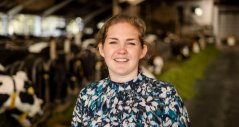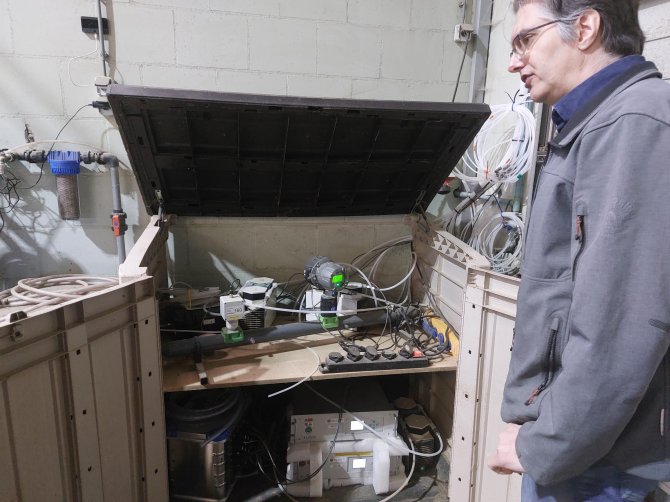At WUR's De Marke experimental farm, sensors measure ammonia and greenhouse gas emissions from dairy cattle. The study aims to clarify whether the system provides a suitable basis for granting environmental permits to livestock farmers. But it is not that simple.
Agro-innovation centre De Marke is a dairy farm with 80 cows on sandy soil in the Achterhoek region. WUR has been researching the cycle between cows, manure, soil and crops here for over thirty years. The farm also aims to minimise its ammonia and methane emissions and the amount of nitrate leaching for the benefit of nature, water quality and climate.
At the end of last year, De Marke was designated by the Ministry of Agriculture, Nature and Food Quality (LNV) as a national test site to measure barn emissions with sensors. Multiple ammonia, methane and CO2 sensors have been installed in the barn.
Ventilation
Measuring emissions is not easy because it is a barn with natural ventilation. The sides of the barn are open: this is where fresh air enters the barn, warms up and is released through vents in the ridge of the roof, says research associate Jan Vonk, who is carrying out the measurements. For this reason, most sensors are installed several metres below the ridge. There, the sensors measure ammonia and methane concentrations, which Vonk converts to emissions from the barn.
Because a dairy farm also has emissions outside the barn, Vonk wants to measure there too at a later stage, for example during manure application on the land. This is done with low-emission application (slurry injection), but Vonk is keen to measure on site how low the emissions are then. He also wants to measure ammonia and methane concentrations in the vicinity of the farm to get a more complete picture of the environmental impact of this experimental farm.
Emission factors
Currently, the government still calculates with emission factors: each cow in barn type A emits x kilos of ammonia. That figure is based on research and measurements, but is an average, expressed as a Rav value. The variation between farms is great, Vonk realises, and management plays an important role in this: working carefully and having less protein in the fodder leads to much lower emissions. Vonk feels that measuring helps determine the actual emissions. For example, he now knows that while De Marke has ammonia emissions of 11.8 kilos of ammonia per animal place per year on paper, the actual emissions are about 6 kilos - so half as much.
According to Vonk, the KringloopWijzer is also an important indicator of emissions, because this tool shows the mineral efficiency on a farm. Nevertheless, emission factors will probably continue to be used as well, because it is not technically possible to measure everywhere.
Nitrate
Calculation is also likely to remain necessary to determine nitrate leaching to groundwater. Measuring nitrate levels in groundwater on a farm is currently still very costly, says farm manager Fleur Brinke. Many samples are needed and the method of sampling is expensive. De Marke also takes soil samples every year to determine how much nitrogen remains in the soil after crops are harvested and could leach into groundwater in the form of nitrate. De Marke uses the measurements to investigate which management measures will reduce nitrate leaching.

Because the barn at De Marke is outdated, Brinke is considering designing a new one. 'In the design process, we encounter many dilemmas. The solution to one goal is not always a solution to another. For example, one barn delivers more animal welfare, another is better at limiting nitrogen emissions and the third barn has a good climate score.' For that reason, Brinke feels that farmers should first learn what targets they need to meet, what their environmental performance is and what adjustments they can make to meet the targets.
Sensors
Vonk shows the measurement systems in the barn. There are now three wires hanging along the length of the barn with sensors from different companies attached to them. Vonk doesn't have any results yet, but can say that some of them are "doing pretty well". Sensors have also been installed in a number of other dairy farms with which WUR is collaborating in various projects. This provides experience in several practical conditions as well as in other animal sectors.

Besides the sensor systems with measurement pipe, there is a so-called open path measurement, in which a laser beam measures the gases (ammonia and methane) in the barn. This system, designed by research institute OnePlanet in Wageningen, could be an alternative to sensor systems, but is not yet fully developed. The laser system seems to work well, but needs to be price-competitive if it is to play a role, says Vonk.
Outside the barn
The barn accounts for roughly half of the ammonia emissions on a dairy farm, says Vonk. The other half occurs outside the barn. We therefore also check out the 7 sensor poles outside in the yard. According to Vonk, these poles won't measure the company's exact emissions. However, you can use these sensors to interpret events, such as manure application. 'You can then see a spike.' Vonk: 'These outdoor sensors provide insight into concentrations and patterns, allowing livestock farmers to draw up a strategy to reduce emissions.'
Invariably, there are also vulnerabilities to the measurement system. For example, the sensors sometimes need to measure very low concentrations, and by no means all sensors succeed in doing so. Moreover, measured concentrations - especially outside the barn - depend on environmental factors, such as wind force and wind direction. This means that the concentration may vary while the emission source does not change. Vonk is just saying: sensors inside and outside the barn can give 'a reasonable estimate' of a dairy farm's total nitrogen and greenhouse gas emissions, but it is not that simple.






